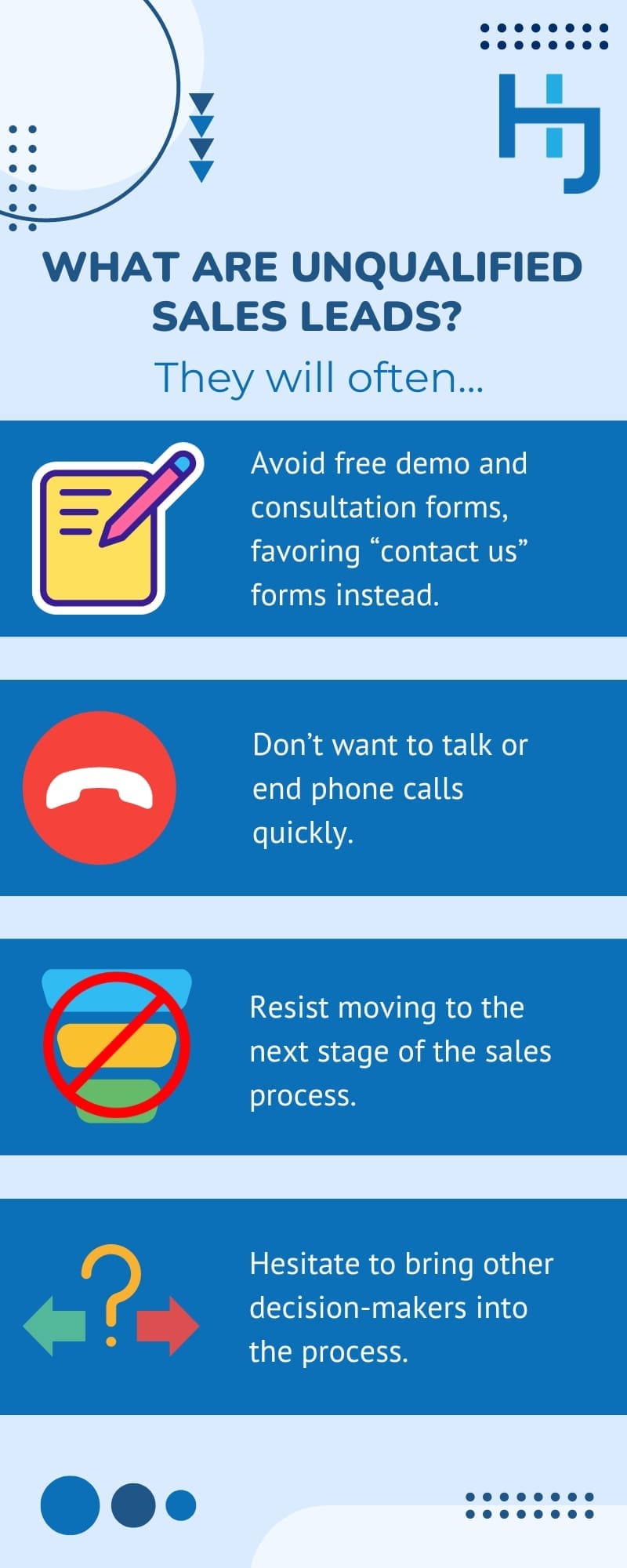
Is your sales team spending hours on the phone and still not closing sales? Or maybe closing them, but only to watch them churn immediately after? The problem may be how you’re handling unqualified leads.
Unqualified sales leads can seep into your CRM and may even make your marketing metrics look great at a glance. After all, who doesn’t like leads? But, it’s not always easy to know if the lead you’re working with is going to convert or if it’s going to rob you of your valuable time. There are distinguishing characteristics that can help your reps tell them apart, though. Give me five minutes, and I’ll teach you what to look for and what to do with your unqualified leads once you know how to spot them.
What Are Qualified Sales Leads?
Think of the buying cycle as a whole. When your sales and marketing teams are aligned, a prospect is carried through the sales funnel step by step. Maybe he’ll be introduced to your product or service through a blog post and/or pick up other valuable information from your website. Next, he’ll spend time engaging with marketing content and, when he’s ready, will make a phone call or fill out a form and become an inbound lead. From there, your sales rep will use your pre-determined criteria to see if he’s a qualifying lead who is ready to make a purchase.
To be considered a qualified lead, he’ll need to:
- Have a problem your company can solve.
- Be able to work within your price range.
- Be a decision-maker or influencer on the purchase.
When potential prospects meet all three rules, they’re ready to move to the next stage of the sales cycle and work with a rep who can close the deal.
What Are Unqualified Sales Leads?
Unfortunately, inbound marketing doesn’t always go that smoothly. Sometimes the content strategy is off, or buyer personas aren’t used, and your company winds up attracting the wrong people. Sometimes people wind up in the sales pipeline purely because they couldn’t find the info they needed and filled out a form hoping to get an answer. Some businesses skip the lead qualification process altogether too.

In short, you’ll know someone is an unqualified lead if they’re missing any parameter of the three mentioned above. You either can’t solve their problem, they can’t afford your solution, or they have no say in the purchase. You may also be able to recognize them because they often:
- Avoid free demo and consultation forms, favoring “contact us” forms instead.
- Don’t want to talk or end phone calls quickly.
- Resist moving to the next stage of the sales process.
- Hesitate to bring other decision-makers into the process.
Resist the Urge to Try to Turn an Unqualified Lead into a Qualified Lead
One of the biggest challenges in both B2C and B2B sales is that reps, trying to meet their quotas, sometimes try to keep pushing a lead through the sales funnel even when these warning signs appear. Yes, you can close a sale even if your product or service is not right for a prospect’s needs. You can close a sale even if your options are well outside the prospect’s budget too. In the end, though, you’re going to wind up with a sky-high churn rate. Your new customers will leave, and you’ll be back at square one.
Know Your Ideal Customer
If you want quality leads, make sure your lead generation strategy is attracting the right people. Both B2C and B2B marketers should be working with buyer personas and creating content that speaks to their exact needs. Your sales and marketing teams should also be in communication so that the marketing team knows why leads are not qualifying. For example, if you’re getting lots of inbound leads but all they want is pricing, they’re not qualified leads. Your marketing team can address this for you by creating clearer messaging around pricing. If you’re a B2B company and getting B2C leads, your marketing team can also address that through their content strategy. Your reps handling the lead qualification will need to know the criteria for an ideal customer too. That way, they know how to handle the ones who aren’t a good fit.
Drop Unqualified Leads That Aren’t a Good Fit
When it comes to managing unqualified leads, the drop and drip approach works best. If a lead doesn’t fit your ideal customer profile, it’s best to drop them. These are people that in no way, shape, or form will ever be your ideal customer, such as B2C leads coming into your B2B business. If you’re using a CRM like Salesforce, you can archive them for tracking purposes.
But, don’t simply click them out of sight and be done with them! They still have value to another company that can meet their needs and, thus, are still valuable to you. Instead, build up a referral partner network. This should include businesses that share your audience but don’t directly compete with you. For example, let’s say you run a staffing company that provides security personnel. You might occasionally receive leads looking for IT and computer security. You can’t help the lead who needs IT help, but if you’re partnered with someone who provides it, you can send the lead to your referral partner. In exchange, your referral partner will send you leads that don’t align with their business. If your referral partner is someone you cannot receive reciprocal referrals from, a commission-based approach can help improve your return on marketing investment (ROMI) too.
Drip Potential Prospects That Might Become Qualified Sales Leads Later

On the other hand, some prospects may not be qualified now but could become qualified later. This might be the case if:
- Your prospect is re-evaluating their internal processes and needs to solve that before moving forward.
- You’re offering an enterprise solution, and they’re not ready to level up yet.
- Their budget is too small right now.
- Their budget will not become available for six months or more. (Some shorten this to three or four months, depending on the niche.)
- Your product is missing a feature your prospect needs, but it’s a planned improvement.
Because circumstances change, you’ll want to track the reason why each lead is unqualified and add them to a drip campaign that speaks to their concerns. Known as nurturing, this automated process helps reinforce the relationship your team began building with the prospect until the circumstances change and they’re ready to move forward.
Get Help Attracting Qualified Leads and Nurturing Unqualified Leads
As a business and digital marketing consultant, I’ve helped countless teams improve their speed-to-lead, cut out wasted time on unqualified leads, and attract more qualified leads to create transformative results for their companies. Although I’ve worked with multinational corporations and Fortune 100 companies, I prefer to work with small and midsize companies that are as eager to move their businesses forward as I am. If that sounds like you, please contact me for a complimentary consultation.





































































